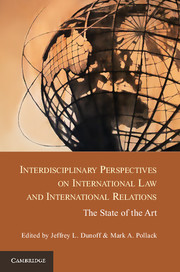 Interdisciplinary Perspectives on International Law and International Relations
Interdisciplinary Perspectives on International Law and International Relations Book contents
- Frontmatter
- Contents
- Contributors
- Acknowledgments
- Part I Introduction: Setting the Stage
- Part II Theorizing International Law
- Part III Making International Law
- 7 Flexibility in International Agreements
- 8 Hard and Soft Law
- 9 Nongovernmental Organizations in International Relations (Theory)
- 10 Regulatory Networks
- 11 Law-Making by International Organizations
- 12 Institutional Proliferation and the International Legal Order
- 13 Legitimacy in International Law and International Relations
- Part IV The Interpretation and Application of International Law
- Part V Enforcement, Compliance, and Effectiveness
- Conclusions
- Index
- References
10 - Regulatory Networks
Power, Legitimacy, and Compliance
Published online by Cambridge University Press: 05 January 2013
- Frontmatter
- Contents
- Contributors
- Acknowledgments
- Part I Introduction: Setting the Stage
- Part II Theorizing International Law
- Part III Making International Law
- 7 Flexibility in International Agreements
- 8 Hard and Soft Law
- 9 Nongovernmental Organizations in International Relations (Theory)
- 10 Regulatory Networks
- 11 Law-Making by International Organizations
- 12 Institutional Proliferation and the International Legal Order
- 13 Legitimacy in International Law and International Relations
- Part IV The Interpretation and Application of International Law
- Part V Enforcement, Compliance, and Effectiveness
- Conclusions
- Index
- References
Summary
Cross-border collaboration among domestic regulatory agencies has become a defining feature of contemporary global governance. Substate actors meet with their peers from other jurisdictions to exchange information, coordinate enforcement, and even to harmonize the regulatory rules applied at home (Keohane and Nye 1977; Raustiala 2002; Slaughter 2004). Both the international relations (IR) and international law (IL) literatures have taken note of this form of transgovernmental cooperation, and a term in both literatures has been minted and widely adopted. “Regulatory networks” appear in myriad areas where globalization has affected a regulatory project shared across borders by agencies, industries, and interest groups. In many instances, economic interdependence forges interactions among jurisdictions with distinct domestic rules. The resulting governance frictions produce the impetus for regulatory interactions among domestic authorities delegated with responsibilities for market oversight. There are regulatory networks in antitrust (Whytock 2005; Damro 2006), aviation (Bermann 1993), data privacy (Bignami 2005; Newman 2008a), human rights (Cardenas 2003), national security (Krahmann 2003; Lipson 2005), and telecommunications (Bermann 1995) regulation, just to name a few.
In the world of financial regulation alone, which has been a particularly welcoming one for such networks, American regulators have joined the International Organization of Securities Commissions (IOSCO), the Basel Committee on Banking Supervision, the Participants Group of major export credit agencies, the Financial Action Task Force (which deals with money laundering), the International Association of Insurance Supervisors (IAIS) the semi-private International Accounting Standards Board, and the mostly private World Federation of Exchanges. In addition, the new Financial Stability Board (FSB) is meant to serve as a network of networks, coordinating the harmonization of financial regulation done by other financial regulatory networks and staffed, like them, by domestic agency officials (Singer 2004; Zaring 2005; Baker 2009; Posner 2009; Helleiner 2010; Bach and Newman 2010a; Brummer 2012).
- Type
- Chapter
- Information
- Interdisciplinary Perspectives on International Law and International RelationsThe State of the Art, pp. 244 - 265Publisher: Cambridge University PressPrint publication year: 2012
References
- 1
- Cited by
